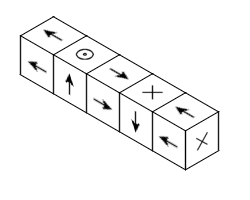Yesterday I learned about the Halbach array, a wonderful way of arranging magnets that was first discovered by John Mallinson in 1973, and then rediscovered by Klaus Halbach a decade later. Why it’s not called a Mallinson array is beyond me.
To make a Halbach array you can arrange magnets in a line, rotating each successive magnet’s orientation by 90o, as in the picture below:

When you do this, it turns out that there is very little magnetic field above the array, and a very strong magnetic field below it. It’s not too hard to see why this happens, and I encourage you to read the Wikipedia page, which explains it quite well.
This “magnetic on one side but non-magnetic on the other side” property has many uses. One of those uses is ordinary refrigerator magnets — in case you’ve ever wondered why refrigerator magnets are only magnetic on one side. Another use is as a component in levitated trains, which is extremely cool.
It occurred to me today that rolling a cylindrical magnet on a table — if the magnet is magnetized across its diameter — should produce the same effect as a Halbach array, since the magnetic orientation will rotate in just the right way as the magnet rolls along.
As it happens, I had such a magnet, so I decided to test this hypothesis.
I suspended a steel spring precariously between two Nespresso packets (since they happened to be just the right height):

As you can see below, if the magnet — which was quite powerful — got anywhere near the spring, the spring would jump off its Nespresso packet supports and snap to the magnet:

Then I tried rolling the magnet under my delicate little suspension bridge. Sure enough, the spring would stay on the bridge while the powerful magnet rolled right under it:



I suspect that this only works because of hysteresis in the steel. The spring takes a little time to change its magnetic orientation in response to the rolling magnet, and so the reaction of the spring to the magnet is smeared out over time. To the spring, the magnet appears like a continuous Halbach array, which has a reduced magnetic field above it.
If this theory is correct, then when the spring is below the table the opposite would occur: The rolling magnet would very strongly attract the spring. Maybe I should try that next.
If this was the cause of the reduced magnetic field, wouldn’t you expect to get the strong field effect when rolling the magnet back the other way? Easier than suspending the spring under the table, anyway.
I didn’t see any mention of continuous rotation on the wikipedia page, it seems that being 90 degrees out of phase is essential. Maybe the hysterises was all that was involved, or that the only net attraction produced by the rotating field was vertical, rather than a Halbach effect.
No, being 90 degrees out of phase is not essential. In contrast, that is just an economical way to manufacture a part that approximates a continuous variation in phase. The continuous version, while difficult to manufacture, produces a stronger and more even effect.
It makes no difference which way the magnet rolls. Whichever way it rolls, the direction toward the surface that it rolls upon has the enhanced magnetic field. The direction opposite to that (ie: above the rolling magnet) has the reduced magnetic field.
Ok, I see that I’ve missed a point.
So if you had a board rolling on top of the cylinder as it rolls on the table, something sitting on (and travelling with) that board would see the strong field?